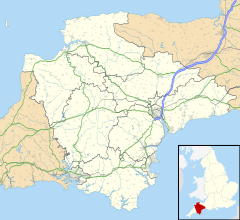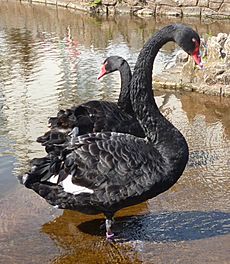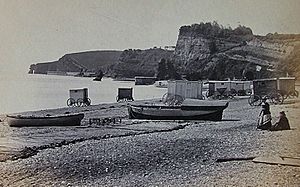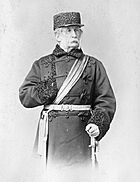Dawlish facts for kids
Quick facts for kids Dawlish |
|
|---|---|
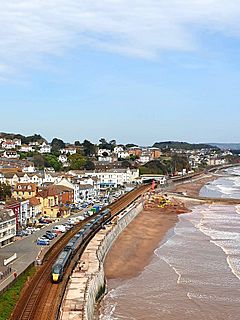 The seafront at Dawlish |
|
| Population | 15,257 (2021 Census) |
| OS grid reference | SX963767 |
| Civil parish |
|
| District |
|
| Shire county | |
| Region | |
| Country | England |
| Sovereign state | United Kingdom |
| Post town | DAWLISH |
| Postcode district | EX7 |
| Dialling code | 01626 |
| Police | Devon and Cornwall |
| Fire | Devon and Somerset |
| Ambulance | South Western |
| EU Parliament | South West England |
| UK Parliament |
|
Dawlish is a charming seaside resort town in Devon, England. It's located on the south coast, about 12 miles (19 km) from the city of Exeter and also near Torquay. In 2021, about 15,257 people lived there. Dawlish started as a small fishing port in the 1700s. Over time, it grew into a popular holiday spot, just like its neighbour, Teignmouth.
Contents
What is Dawlish Like?
Dawlish sits where a small river, called Dawlish Water (or The Brook), meets the sea. It's nestled between red sandstone cliffs. The town has a sandy beach with a railway line running along the coast. Right behind the beach is a public park called The Lawn, where Dawlish Water flows through.
Just south-west of Dawlish is a rocky area called Lea Mount. You can walk along the seawall path to Coryton Cove, which is a lovely part of the beach. To the north-east, you can follow the coast towards Langstone Rock and Dawlish Warren.
Dawlish is also famous for its black swans. These beautiful birds originally came from Western Australia. They live with other interesting waterfowl in a special park area on Dawlish Water.
Where Did the Name Dawlish Come From?
The name Dawlish comes from an old Welsh river name. It means 'black stream'. Some old records also show a Roman name, Dolfisc, which meant 'Dark river' or 'The Devils Water'. The town was first mentioned in writing in 1044 as Doflisc. Over the years, its name changed a few times, becoming Dawlisshe by 1468.
A Brief History of Dawlish
Long ago, before Dawlish became a town, fishermen and salt makers visited the coast. They made salt in special areas called salterns. However, the local stream, Dawlish Water, often flooded. This made nearby Teignmouth a better place for salt-making. So, salt production stopped in Dawlish during the Anglo-Saxon period (around 400–1000 AD).
The first settlement in Dawlish was built almost a mile away from the coast. This was near where the parish church stands today. People chose this spot because the land was fertile and safe from floods.
In 1044, the land that includes Dawlish was given to Leofric, who later became the first Bishop of Exeter. The church owned the land until 1802.
Dawlish remained a quiet fishing village until the late 1700s. At that time, seaside towns became popular with wealthy people. This happened partly because King George III started taking his summer holidays in Weymouth in 1789. By 1795, Dawlish was so fashionable that holiday homes became very expensive to rent.
In the early 1800s, the area between the old village and the sea was changed. The stream was made straighter, and small waterfalls were added. A wide lawn was created, with new houses built along its sides. This layout still looks much the same today.
You can learn more about Dawlish's journey from a fishing village to a Victorian holiday spot at the Dawlish Museum.
Brunel's Amazing Railway
In 1830, the famous engineer Isambard Kingdom Brunel designed a special railway for Dawlish. This railway used a unique system called a pneumatic system, which used air pressure to move trains. One of the pumping stations for this system was in Dawlish. The railway line ran right along the seafront. Brunel made sure the line crossed the river mouth on a small granite bridge, so people could still get to the beach.
The atmospheric railway opened on May 30, 1846. It ran between Exeter St. Davids and Newton Abbot. The first passenger train ran in September 1847. However, the project had many problems, especially with the leather seal that helped the system work. It was very expensive to fix. Because of these issues, the railway company decided to switch to normal trains. The last atmospheric train ran in September 1848.
Dawlish in Books
The famous writer Jane Austen visited Dawlish in 1802. She later mentioned the town several times in her 1811 novel Sense and Sensibility. In Charles Dickens' book Nicholas Nickleby (1838–39), the main character inherits a small farm near Dawlish.
Famous People from Dawlish
Many interesting people have connections to Dawlish:
- Thomas Vowler Short (1790–1872): A scholar and church leader.
- Field Marshal Sir John Michel (1804–1886): A British Army officer who served in important wars.
- Herman Merivale (1806–1874): A British civil servant and historian.
- Robert J. Shuttleworth (1810–1874): An English botanist who studied plants and snails.
- Colonel Sir Arthur George Hammond (1843–1919): A brave soldier who received the Victoria Cross.
- H. O. Arnold-Forster (1855–1909): A British politician and writer.
- Captain Henry Singleton Pennell (1874–1907): Another soldier who received the Victoria Cross.
- Igerna Sollas (1877–1965): A British zoologist and geologist.
- Aylward M. Blackman (1883–1956): An Egyptologist who explored ancient sites in Egypt.
- Paul Britten Austin (1922–2005): An author and translator of Swedish literature.
- Sir Adrian Frederick Melhuish Smith (born 1946): A well-known statistician.
Getting Around Dawlish
Railway Travel
Dawlish railway station is right in the town centre, next to the beach. Two train companies use this station:
- Great Western Railway runs regular trains between Exmouth, Exeter, and Paignton. Some longer-distance trains also stop here.
- CrossCountry services from Manchester Piccadilly to Paignton stop here twice a day.
The railway line along the coast is very beautiful. However, it's also very expensive to maintain because of sea erosion. For example, a storm in 1974 washed away part of the station platform. In 2014, huge waves destroyed a section of the sea wall and railway line. This storm made people wonder if the railway line should be moved further inland. Since 2019, Network Rail has been working to improve the sea defences along the wall. This project was finished in July 2023.
Roads and Buses
The A379 road runs through Dawlish, parallel to the railway line. This road connects Dawlish to Exeter, Teignmouth, Torbay, Dartmouth, and Plymouth.
Buses in Dawlish are mainly run by Stagecoach South West. Key routes include:
- Route 2: From Exeter to Newton Abbot.
- Route 22: From Dawlish Warren to Torquay.
- Route 186: Connects the town centre, hospital, and Sainsbury's to housing areas.
Dawlish Weather
Dawlish has a mild, oceanic climate. It's often called the "English Riviera" because it rarely gets snow or frost. You can even see subtropical plants like palms and lemon trees growing outdoors. Temperatures usually stay between 0°C and 30°C. Dawlish is one of the sunniest places in Britain, with almost 1800 hours of sunshine each year. While summers are nice, autumn and winter can bring a lot of rain and strong winds from the English Channel.
Local Products
In the early to mid-1900s, Dawlish was known for its Devon Violets perfume. Hundreds of different violet types were grown in local gardens. Today, you can still find wild violets growing around the area. More recently, Dawlish has become known for growing dianthus, freesias, daffodils, tomatoes, and strawberries.
Shopping and Jobs in Dawlish
Dawlish has many shops and places to eat, especially around The Strand, Queen Street, and Park Road. You'll find gift shops, cafes, bakeries, restaurants, pubs, and ice-cream shops. There are also some national chain stores and many independent shops. Near the railway station and seafront, you'll find more ice-cream shops, a restaurant, and a sports bar. In recent years, many art, craft, and antique shops have opened. At the north-eastern end of town, there's a large Sainsbury's supermarket with an Argos and a petrol station.
The biggest job sector in Dawlish is health and social work, with many care homes. Accommodation and food services also provide a lot of jobs.
Places of Worship
Dawlish has several churches:
- Hope Church (DCF)
- Dawlish Baptist Church
- Dawlish Methodist Church
- Dawlish Strand Church (United Reformed)
- St Agatha's Church (Roman Catholic)
- St Gregory's Church (Anglican)
Schools in Dawlish
The primary schools in Dawlish are Gatehouse Primary School, Westcliff Primary School, and Orchard Manor School. Dawlish College is the main secondary school. Oakwood Court College is a special college for students with particular needs.
How Dawlish is Governed
Locally, Dawlish is run by the Dawlish Town Council. The next level of local government is the Teignbridge District Council. Dawlish is part of the parliamentary constituency of Newton Abbot.
Twin Town
Dawlish is twinned with Carhaix-Plouguer, a town in Brittany, France.
See also
 In Spanish: Dawlish para niños
In Spanish: Dawlish para niños


